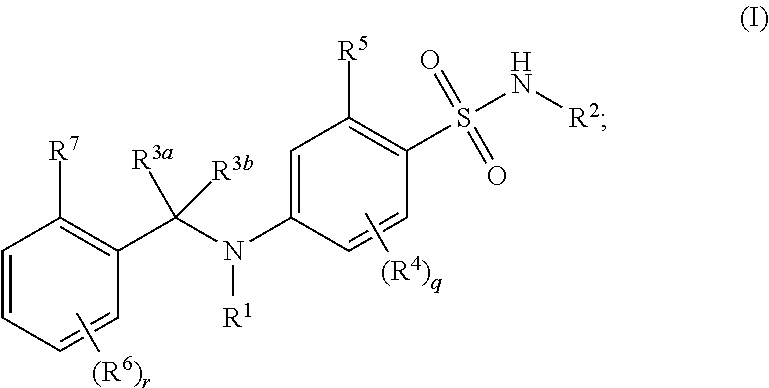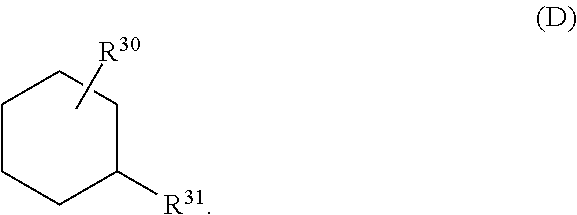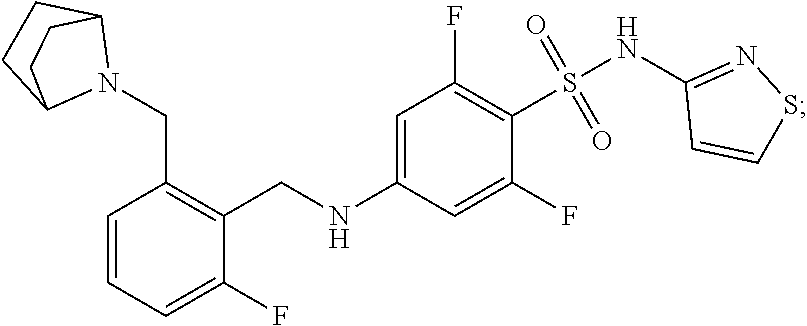Benzenesulfonamide compounds and their use as therapeutic agents
a technology of benzenesulfonamide and compound, which is applied in the direction of drug composition, organic chemistry, nervous disorders, etc., can solve the problems of inability of those neurons to activate and release gaba, loss of inhibitory tone of the brain, and failure to contain the excitability of glutamatergic neurons, so as to increase the potency of existing or future drug therapy and reduce adverse events
- Summary
- Abstract
- Description
- Claims
- Application Information
AI Technical Summary
Benefits of technology
Problems solved by technology
Method used
Image
Examples
example 1
Synthesis of 4-((2-((7-azabicyclo[2.2.1]heptan-7-yl)methyl)-6-fluorobenzyl)amino)-2,6-difluoro-N-(isothiazol-3-yl)benzenesulfonamide
[0318]
Step 1. Preparation of 2-((7-azabicyclo[2.2.1]heptan-7-yl)methyl)-6-fluorobenzonitrile
[0319]
[0320]To a solution of 2-(bromomethyl)-6-fluorobenzonitrile (6.95 g, 32.5 mmol) and 7-azabicyclo[2.2.1]heptane hydrochloride (4.35 g, 32.5 mmol) in anhydrous dimethyl sulfoxide (60 mL) was added potassium carbonate (9.0 g, 65.2 mmol). The resulting suspension was stirred at ambient temperature for 12 h. The mixture was then diluted with ethyl acetate (400 mL) and water (100 mL). The aqueous layer was separated and extracted with ethyl acetate (2×100 mL). The combined organic layers were washed with brine (3×100 mL), dried over anhydrous sodium sulfate, filtered and the filtrate concentrated in vacuo. The residue was purified by column chromatography, eluting with a gradient of 0 to 5% methanol in dichloromethane, to yield the title compound as a yellow oil ...
example 2
Synthesis of 2,6-difluoro-4-((6-fluoro-2-((isopropyl(methyl)amino)methyl)-3-methoxybenzyl)amino)-N-(thiazol-4-yl)benzenesulfonamide
[0336]
Step 1. Preparation of Tert-Butyl Thiazol-4-ylcarbamate
[0337]
[0338]To a solution of thiazole-4-carboxylic acid (150.0 g, 1.16 mol) in anhydrous tert-butanol (1000 mL) was slowly added triethylamine (156.7 g, 1.55 mol) and diphenyl phosphoryl azide (383.6 g, 1.39 mol). The reaction mixture was stirred at ambient temperature for 0.5 h and then heated to 90° C. for 3 h. After cooling to ambient temperature, the reaction mixture was concentrated under reduced pressure. The obtained residue was diluted with petroleum ether (1000 mL) and water (1000 mL), and the mixture was stirred at ambient temperature for 12 h. The mixture was filtered and the filter cake was extracted with ethyl acetate (3×1000 mL). The combined organic phase was washed with brine (3×1000 mL), dried over anhydrous sodium sulfate, and filtered. Concentration of the filtrate provided a...
example 3
Synthesis of 4-((2-((7-azabicyclo[2.2.1]heptan-7-yl)methyl)-6-fluorobenzyl)amino)-2,3-difluoro-N-(thiazol-4-yl)benzenesulfonamide
[0355]
Step 1. Preparation of Tert-Butyl thiazol-4-yl((2,3,4-trifluorophenyl)sulfonyl)carbamate
[0356]
[0357]To a solution of tert-butyl thiazol-4-ylcarbamate (2.87 g, 14.3 mmol) in anhydrous tetrahydrofuran 50 mL) was added a 1 M solution of lithium bis(trimethylsilyl)amide in tetrahydrofuran (14.3 mL, 14.3 mmol) at −50° C. The reaction mixture was allowed to warm to 0° C. and stirred for 1 h. After cooling the reaction mixture to 0° C., a solution of 2,3,4-trifluorobenzenesulfonyl chloride (3.0 g, 13.0 mmol) in anhydrous tetrahydrofuran (60 mL) was slowly added to the reaction mixture. The reaction mixture was allowed to warm to ambient temperature, stirred for 12 h, and then quenched by addition of saturated aqueous ammonium chloride (50 mL). The mixture was extracted with ethyl acetate (3×100 mL). The combined organic phase was washed with brine (2×50 mL)...
PUM
| Property | Measurement | Unit |
|---|---|---|
| temperature | aaaaa | aaaaa |
| temperature | aaaaa | aaaaa |
| temperature | aaaaa | aaaaa |
Abstract
Description
Claims
Application Information
 Login to View More
Login to View More - R&D
- Intellectual Property
- Life Sciences
- Materials
- Tech Scout
- Unparalleled Data Quality
- Higher Quality Content
- 60% Fewer Hallucinations
Browse by: Latest US Patents, China's latest patents, Technical Efficacy Thesaurus, Application Domain, Technology Topic, Popular Technical Reports.
© 2025 PatSnap. All rights reserved.Legal|Privacy policy|Modern Slavery Act Transparency Statement|Sitemap|About US| Contact US: help@patsnap.com



